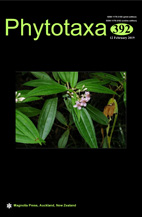Abstract
In order to evaluate the monophyly of the genus Orleanesia (Orchidaceae) and to assess its position within Laeliinae, a phylogenetic analysis was performed using molecular (nuclear ITS and plastid matK DNA sequences) and morphological data. A taxonomic revision of Orleanesia was also performed, with a description of the genus and its species using fresh living plants and 115 exsiccates from 31 herbaria. All phylogenetic analyses were highly congruent, and thus the sequence data from all three data sets were combined. The resulting phylogeny corroborated the monophyly of Orleanesia, with two strongly supported clades, and confirmed Caularthron as its sister group. Character analysis was not very informative due to a high degree of homoplasy. Two lectotypifications and three new synonyms were proposed for the genus, thereby reducing the number of accepted species to six. Although none of the species of Orleanesia are considered endangered, it is clear that some populations are threatened with deforestation and habitat reduction.

